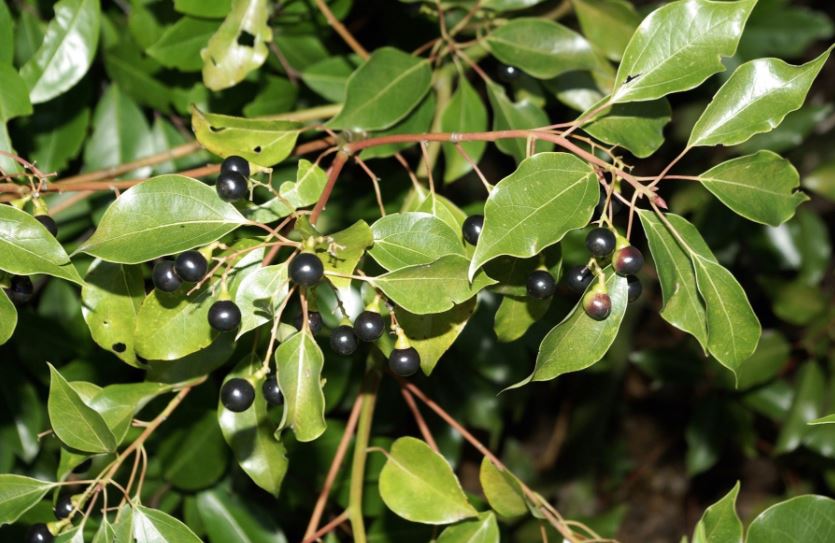
The camphor tree, scientifically known as Cinnamomum camphora is a species of evergreen tree indigenous to warm temperate to subtropical regions of East Asia, including countries such as China, Taiwan, Vietnam, Korea, and Japan. It is known by various names, most notably the camphor tree, camphorwood or camphor laurel.
Camphor trees are also widely distributed on the African continent from the eastern parts of the DRC and Rwanda, throughout eastern Africa to northern parts of Malawi and Zambia. More common in wetter forests.
Camphor trees are large, often reaching heights of 30 meters (100 feet) or more. They have a broad, spreading crown with a straight trunk. In its early years, the camphor tree exhibits a moderate to fast growth rate. Under optimal conditions, it can grow several feet per year. As it matures, the growth rate slows down, but the tree continues to grow in both height and spread, developing a broad canopy. The tree reaches maturity within 20-30 years, where it starts producing seeds. Some specimens in Japan, for example, are over 1,000 years old, with one famous tree at the Takeo Shrine believed to be around 3,000 years old.
The leaves are oval or elliptic. They taper at both ends, with the leaf base often being slightly asymmetrical. They are dark green on the upper surface and slightly lighter underneath.The leaves have a glossy, waxy appearance and smell of camphor when crushed. This aroma comes from the volatile oil, camphor, which is stored in small glands within the leaf tissue.The camphor scent serves as a natural defense against herbivores and pests.
In spring, it produces bright green foliage with masses of very small white fragrant flowers from which its common namesake “smells good tree” in Chinese was given. It produces clusters of black, berry-like fruit around 1 cm (3⁄8 in) in diameter. Its pale bark is very rough and fissured vertically. The fruit is a black berry, about 1 cm in diameter, containing a single seed. The bark is greyish-brown and becomes fissured with age.
Facts
- Camphor trees can become invasive in some regions outside their native range due to their hardy nature and prolific seed production. Always check local regulations regarding planting camphor trees.
- Camphor oil is extracted from the wood and leaves. Harvesting for oil usually involves cutting branches or the entire tree, which is then steam distilled.
- The camphor tree’s leaves and bark have been used in traditional medicine across Asia for centuries, believed to have properties that can treat everything from colds to rheumatism.
- In literature and art, the camphor tree often symbolizes longevity and resilience due to its long lifespan and robust nature.
- Camphor trees can be grown in containers for a few years but will eventually need to be transplanted into the ground due to their size.
- In Australia, the larval stages of two native butterflies, the purple brown-eye and common red-eye feed on camphor despite it being an introduced plant.
Climate and Soil Requirements
- Camphor trees thrive in subtropical to tropical climates. They prefer warm temperatures and are hardy in USDA zones 9-11. They can tolerate light frost but not prolonged cold.
- They prefer well-drained, fertile soil but can adapt to a range of soil types, including sandy, loamy, and clay soils. The pH should ideally be slightly acidic to neutral (6.0-7.5).
Planting
- Camphor tree seeds should be sown in spring. Soak the seeds for 24 hours before planting to improve germination rates. Plant them about 1 cm deep in a seed tray with a good potting mix. Keep the soil moist but not waterlogged.
- If you’re starting with seedlings, plant them in a location where they will have plenty of room to grow, as these trees can reach significant sizes (up to 30 meters or more in height).
- Space trees at least 6-10 meters apart to allow for growth and air circulation.
Care
- Young trees need regular watering to establish a strong root system. Once established, they are relatively drought-tolerant but perform better with consistent moisture.
- Apply mulch around the base of the tree to retain moisture and suppress weeds. Keep mulch away from the trunk to prevent rot.
- Use a balanced fertilizer once or twice a year, especially in spring. Organic compost can also be beneficial.
- Prune to shape the tree or remove dead wood. Camphor trees can be pruned for bonsai or topiary, but generally, they are allowed to grow naturally due to their aesthetic appeal.
Pests and Diseases
- Camphor trees are relatively resistant to pests and diseases, but watch out for scale insects, aphids, and root rot in poorly drained soils.